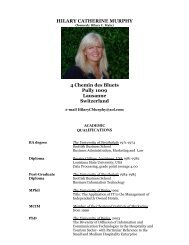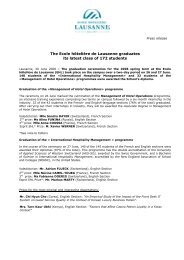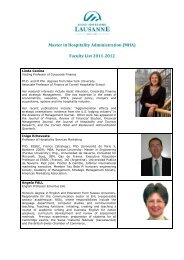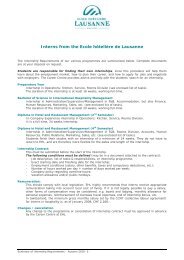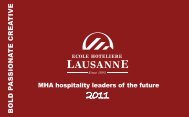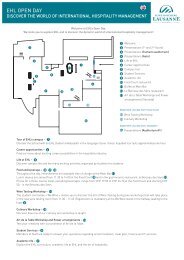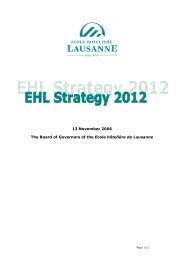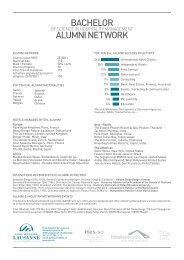EHL Course Catalogue 2011-2012 - Ecole Hôtelière de Lausanne
EHL Course Catalogue 2011-2012 - Ecole Hôtelière de Lausanne
EHL Course Catalogue 2011-2012 - Ecole Hôtelière de Lausanne
You also want an ePaper? Increase the reach of your titles
YUMPU automatically turns print PDFs into web optimized ePapers that Google loves.
� Property type: traditional hotels, special use properties (resorts, medical, convention, cruise<br />
ships, and/or timeshare); restaurants);<br />
� Ownership structure: individual ownership; private partnerships; public-private partnerships;<br />
venture capital; public company.<br />
� Objective<br />
To promote sound hospitality real estate finance <strong>de</strong>cisions.<br />
In this course the stu<strong>de</strong>nt learns how to make estimates of value and to i<strong>de</strong>ntify appropriate<br />
modalities of financing, taking into account a range of factors including:<br />
� Economic and real estate market cycles;<br />
� The current and prospective tax, legal, monetary and regulatory environment;<br />
� Competitive position of markets: their transport infrastructure; <strong>de</strong>mand drivers for business<br />
and tourism; market segmentation; future <strong>de</strong>velopment of capacity; and shifts in competing<br />
markets.<br />
� The supply and <strong>de</strong>mand profile and operating characteristics of a property within a market<br />
and submarket;<br />
� Forecast of revenues and expenses;<br />
� Different asset management structures including: leases; management contracts;<br />
franchises; voluntary affiliations; CRS.<br />
� Diverse financing instruments including: mortgages; leases; sales-leasebacks; mezzanine<br />
financing; bonds and various forms of equity.<br />
8333AC – Market finance<br />
40 hours of contact – 4 US quarter credits - 6 ECTS credits<br />
� Summary<br />
The goal of this course is to provi<strong>de</strong> stu<strong>de</strong>nts with the necessary tools to interpret news from the<br />
international financial markets. Specifically, they will analyse the mechanisms and players of the<br />
money, stocks and bond markets. They will also use standard methods to evaluate assets and to<br />
manage portfolios. The analysis of various types of financial risks and the use of hedging instruments<br />
will be an essential part of this course.<br />
� Objective<br />
At the end of the course, stu<strong>de</strong>nts will be able to estimate and analyse the prices of stocks and bonds<br />
and rates of return. They will also be able to evaluate the performance of a financial investment in<br />
terms of portfolio management. They will also be able to i<strong>de</strong>ntify and quantify financial risks and<br />
suggest means of managing them. Stu<strong>de</strong>nts should therefore be able to:<br />
� Estimate the value of stocks and bonds;<br />
� Analyse the <strong>de</strong>terminants of the rates of return on money, stock and bond markets;<br />
� Assess the sensitivity of financial instruments to changes in economic conditions and<br />
investors' sentiments;<br />
� Build a portfolio and analyse the benefits of diversification;<br />
� I<strong>de</strong>ntify and quantify financial risks and propose methods for managing them.



